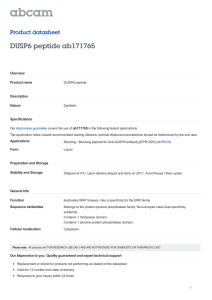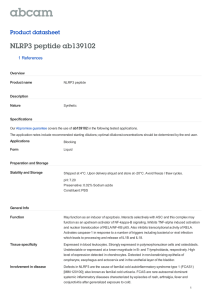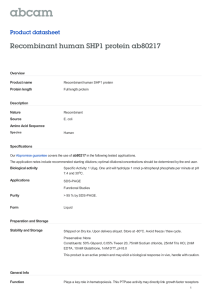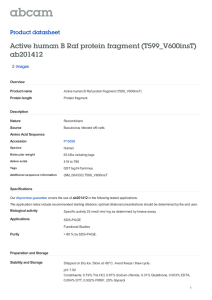Recombinant human SHP2 protein ab42578 Product datasheet 1 References Overview
advertisement
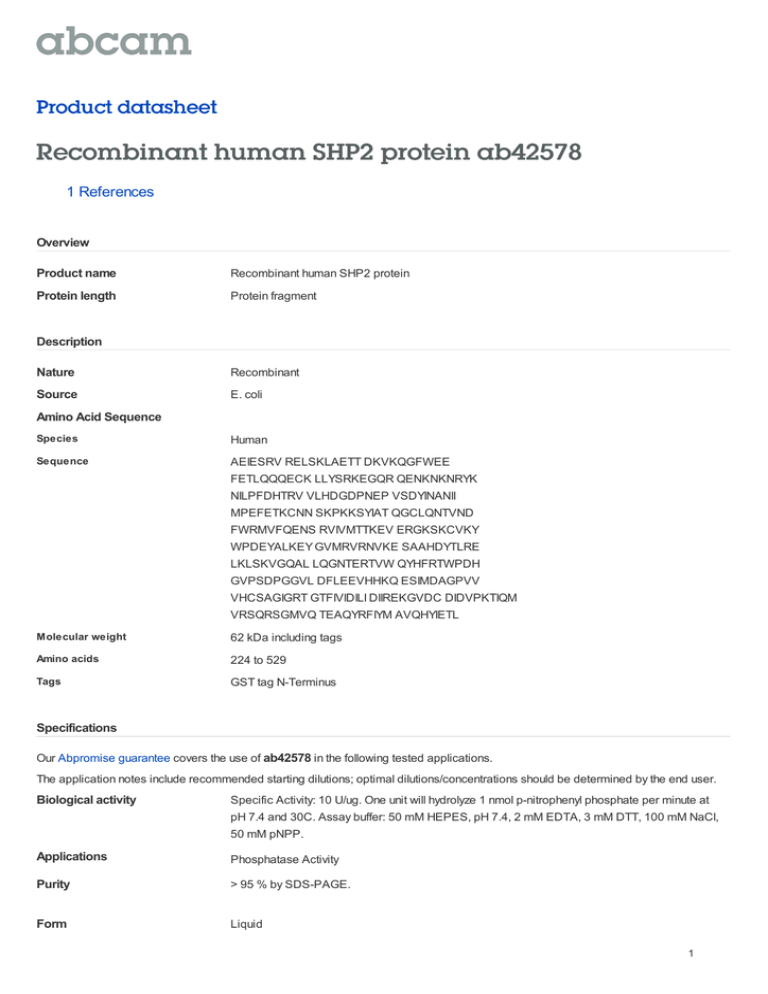
Product datasheet Recombinant human SHP2 protein ab42578 1 References Overview Product name Recombinant human SHP2 protein Protein length Protein fragment Description Nature Recombinant Source E. coli Amino Acid Sequence Species Human Sequence AEIESRV RELSKLAETT DKVKQGFWEE FETLQQQECK LLYSRKEGQR QENKNKNRYK NILPFDHTRV VLHDGDPNEP VSDYINANII MPEFETKCNN SKPKKSYIAT QGCLQNTVND FWRMVFQENS RVIVMTTKEV ERGKSKCVKY WPDEYALKEY GVMRVRNVKE SAAHDYTLRE LKLSKVGQAL LQGNTERTVW QYHFRTWPDH GVPSDPGGVL DFLEEVHHKQ ESIMDAGPVV VHCSAGIGRT GTFIVIDILI DIIREKGVDC DIDVPKTIQM VRSQRSGMVQ TEAQYRFIYM AVQHYIETL Molecular weight 62 kDa including tags Amino acids 224 to 529 Tags GST tag N-Terminus Specifications Our Abpromise guarantee covers the use of ab42578 in the following tested applications. The application notes include recommended starting dilutions; optimal dilutions/concentrations should be determined by the end user. Biological activity Specific Activity: 10 U/ug. One unit will hydrolyze 1 nmol p-nitrophenyl phosphate per minute at pH 7.4 and 30C. Assay buffer: 50 mM HEPES, pH 7.4, 2 mM EDTA, 3 mM DTT, 100 mM NaCl, 50 mM pNPP. Applications Phosphatase Activity Purity > 95 % by SDS-PAGE. Form Liquid 1 Preparation and Storage Stability and Storage Shipped on Dry Ice. Upon delivery aliquot. Store at -80°C. Avoid freeze / thaw cycle. Preservative: None Constituents: 50% Glycerol, 0.05% Tween 20, 75mM Sodium chloride, 25mM Tris HCl, 2mM EDTA, 10mM Glutathione, 1mM DTT, pH 8 This product is an active protein and may elicit a biological response in vivo, handle with caution. General Info Function Acts downstream of various receptor and cytoplasmic protein tyrosine kinases to participate in the signal transduction from the cell surface to the nucleus. Tissue specificity Widely expressed, with highest levels in heart, brain, and skeletal muscle. Involvement in disease Defects in PTPN11 are the cause of LEOPARD syndrome type 1 (LEOPARD1) [MIM:151100]. It is an autosomal dominant disorder allelic with Noonan syndrome. The acronym LEOPARD stands for lentigines, electrocardiographic conduction abnormalities, ocular hypertelorism, pulmonic stenosis, abnormalities of genitalia, retardation of growth, and deafness. Defects in PTPN11 are the cause of Noonan syndrome type 1 (NS1) [MIM:163950]. Noonan syndrome (NS) is a disorder characterized by dysmorphic facial features, short stature, hypertelorism, cardiac anomalies, deafness, motor delay, and a bleeding diathesis. Some patients with Noonan syndrome type 1 develop multiple giant cell lesions of the jaw or other bony or soft tissues, which are classified as pigmented villomoduolar synovitis (PVNS) when occurring in the jaw or joints. Note=Mutations in PTPN11 account for more than 50% of the cases. Rarely, NS is associated with juvenile myelomonocytic leukemia (JMML). NS1 inheritance is autosomal dominant. Defects in PTPN11 are a cause of juvenile myelomonocytic leukemia (JMML) [MIM:607785]. JMML is a pediatric myelodysplastic syndrome that constitutes approximately 30% of childhood cases of myelodysplastic syndrome (MDS) and 2% of leukemia. It is characterized by leukocytosis with tissue infiltration and in vitro hypersensitivity of myeloid progenitors to granulocyte-macrophage colony stimulating factor. Defects in PTPN11 are a cause of metachondromatosis (MC) [MIM:156250]. It is a skeletal disorder with radiologic fetarures of both multiple exostoses and Ollier disease, characterized by the presence of multiple enchondromas and osteochondroma-like lesions. Sequence similarities Belongs to the protein-tyrosine phosphatase family. Non-receptor class 2 subfamily. Contains 2 SH2 domains. Contains 1 tyrosine-protein phosphatase domain. Domain The SH2 domains repress phosphatase activity. Binding of these domains to phosphotyrosinecontaining proteins relieves this auto-inhibition, possibly by inducing a conformational change in the enzyme. Post-translational modifications Phosphorylated on Tyr-546 and Tyr-584 upon receptor protein tyrosine kinase activation; which creates a binding site for GRB2 and other SH2-containing proteins. Cellular localization Cytoplasm. Please note: All products are "FOR RESEARCH USE ONLY AND ARE NOT INTENDED FOR DIAGNOSTIC OR THERAPEUTIC USE" Our Abpromise to you: Quality guaranteed and expert technical support Replacement or refund for products not performing as stated on the datasheet Valid for 12 months from date of delivery Response to your inquiry within 24 hours 2 We provide support in Chinese, English, French, German, Japanese and Spanish Extensive multi-media technical resources to help you We investigate all quality concerns to ensure our products perform to the highest standards If the product does not perform as described on this datasheet, we will offer a refund or replacement. For full details of the Abpromise, please visit http://www.abcam.com/abpromise or contact our technical team. Terms and conditions Guarantee only valid for products bought direct from Abcam or one of our authorized distributors 3
![Anti-SHP2 (phospho Y542) antibody [EP508(2)Y] ab62322](http://s2.studylib.net/store/data/012703520_1-ac096ad4b49a9e61dbc83e12e3b3443b-300x300.png)
